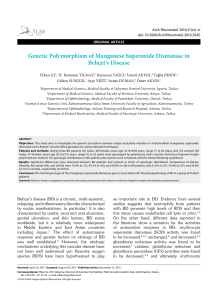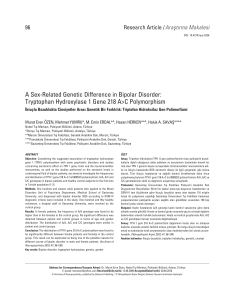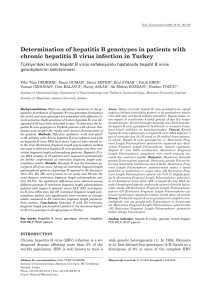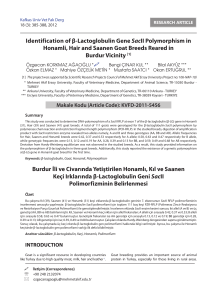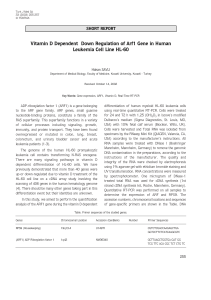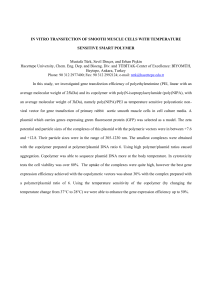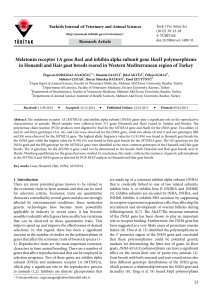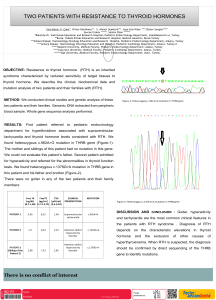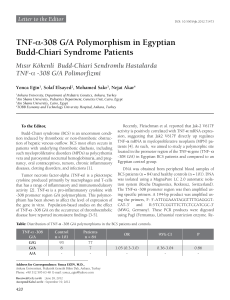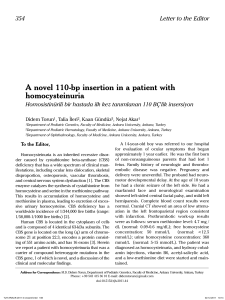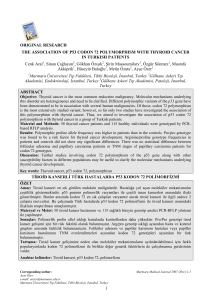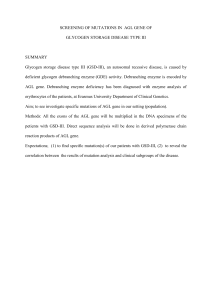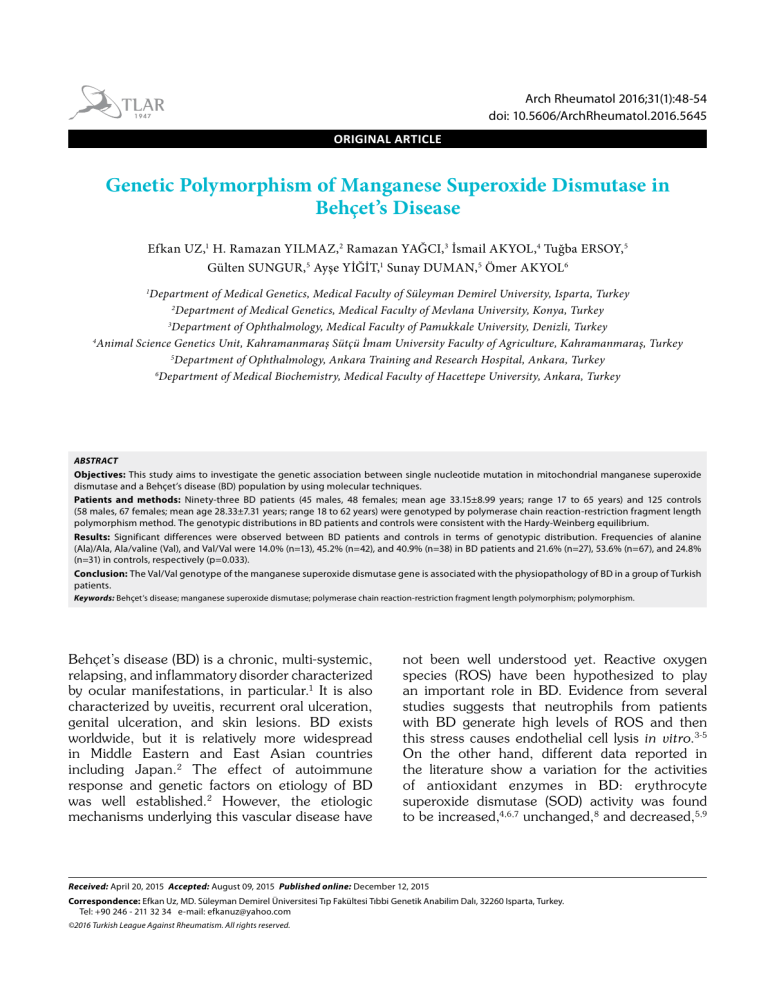
Arch Rheumatol 2016;31(1):48-54
doi: 10.5606/ArchRheumatol.2016.5645
ORIGINAL ARTICLE
Genetic Polymorphism of Manganese Superoxide Dismutase in
Behçet’s Disease
Efkan UZ,1 H. Ramazan YILMAZ,2 Ramazan YAĞCI,3 İsmail AKYOL,4 Tuğba ERSOY,5
Gülten SUNGUR,5 Ayşe YİĞİT,1 Sunay DUMAN,5 Ömer AKYOL6
Department of Medical Genetics, Medical Faculty of Süleyman Demirel University, Isparta, Turkey
2
Department of Medical Genetics, Medical Faculty of Mevlana University, Konya, Turkey
3
Department of Ophthalmology, Medical Faculty of Pamukkale University, Denizli, Turkey
4
Animal Science Genetics Unit, Kahramanmaraş Sütçü İmam University Faculty of Agriculture, Kahramanmaraş, Turkey
5
Department of Ophthalmology, Ankara Training and Research Hospital, Ankara, Turkey
6
Department of Medical Biochemistry, Medical Faculty of Hacettepe University, Ankara, Turkey
1
ABSTRACT
Objectives: This study aims to investigate the genetic association between single nucleotide mutation in mitochondrial manganese superoxide
dismutase and a Behçet’s disease (BD) population by using molecular techniques.
Patients and methods: Ninety-three BD patients (45 males, 48 females; mean age 33.15±8.99 years; range 17 to 65 years) and 125 controls
(58 males, 67 females; mean age 28.33±7.31 years; range 18 to 62 years) were genotyped by polymerase chain reaction-restriction fragment length
polymorphism method. The genotypic distributions in BD patients and controls were consistent with the Hardy-Weinberg equilibrium.
Results: Significant differences were observed between BD patients and controls in terms of genotypic distribution. Frequencies of alanine
(Ala)/Ala, Ala/valine (Val), and Val/Val were 14.0% (n=13), 45.2% (n=42), and 40.9% (n=38) in BD patients and 21.6% (n=27), 53.6% (n=67), and 24.8%
(n=31) in controls, respectively (p=0.033).
Conclusion: The Val/Val genotype of the manganese superoxide dismutase gene is associated with the physiopathology of BD in a group of Turkish
patients.
Keywords: Behçet’s disease; manganese superoxide dismutase; polymerase chain reaction-restriction fragment length polymorphism; polymorphism.
Behçet’s disease (BD) is a chronic, multi-systemic,
relapsing, and inflammatory disorder characterized
by ocular manifestations, in particular.1 It is also
characterized by uveitis, recurrent oral ulceration,
genital ulceration, and skin lesions. BD exists
worldwide, but it is relatively more widespread
in Middle Eastern and East Asian countries
including Japan.2 The effect of autoimmune
response and genetic factors on etiology of BD
was well established.2 However, the etiologic
mechanisms underlying this vascular disease have
not been well understood yet. Reactive oxygen
species (ROS) have been hypothesized to play
an important role in BD. Evidence from several
studies suggests that neutrophils from patients
with BD generate high levels of ROS and then
this stress causes endothelial cell lysis in vitro.3-5
On the other hand, different data reported in
the literature show a variation for the activities
of antioxidant enzymes in BD: erythrocyte
superoxide dismutase (SOD) activity was found
to be increased,4,6,7 unchanged,8 and decreased,5,9
Received: April 20, 2015 Accepted: August 09, 2015 Published online: December 12, 2015
Correspondence: Efkan Uz, MD. Süleyman Demirel Üniversitesi Tıp Fakültesi Tıbbi Genetik Anabilim Dalı, 32260 Isparta, Turkey.
Tel: +90 246 - 211 32 34 e-mail: [email protected]
©2016 Turkish League Against Rheumatism. All rights reserved.
49
Mn-SOD Polymorphism in Behçet’s Disease
glutathione reductase activity was found to be
increased,7 catalase, glutathione reductase and
glutathione peroxidase (GPx) activities were found
to be decreased,5-9 and ultimately, erythrocyte
catalase activity was found to be unchanged4 in
BD patients.
Superoxide dismutase is an enzyme catalyzing
the dismutation reaction of superoxide radicals to
hydrogen peroxide.10,11 SOD, a key antioxidant
enzyme, is a family of enzymes, comprising
copper, zink-SOD, manganese (Mn)-SOD, and
extracellular SOD, whose function is protection
against ROS.2,12 Mn-SOD gene is located on
chromosome 6q25 in mitochondria and it consists
of five exons. Valine-to-alanine (Val-to-Ala)
substitution at codon 16 of human Mn-SOD
might lead to misdirected intracellular trafficking
followed by changes in Mn-SOD activity in the
mitochondria.2,13,14 In this study, we aimed to
investigate the genetic association between single
nucleotide mutation in mitochondrial Mn-SOD and
a BD population by using molecular techniques.
PATIENTS AND METHODS
This multicenter study included 93 BD patients
(45 males, 48 females; mean age 33.15±8.99
years; range 17 to 65 years) and 125 controls
(58 males, 67 females; mean age 28.33±7.31
years; range 18 to 62 years) between October
2004 and July 2005. Clinical and demographic
data were recorded. The study was approved
by the local non-invasive clinical research ethics
committee. All of the participants provided
written informed consent. Patients were diagnosed
according to the International Study Group for
BD.15
Blood samples (5-10
ethylenediaminetetraacetic
mL),
acid
taken in
containing
tubes during vascular access established for the
normal clinical biochemistry tests of participants,
were obtained from volunteer BD patients.
Characteristics of patient and control groups were
summarized in Table 1. Genomic deoxyribonucleic
acid (DNA) was isolated from 300 µL blood using
Promega Wizard Genomic DNA purification Kit
(Promega Corp., Madison, WI, USA). Isolation
process was performed according to the
manufacturer’s recommendations.16 The DNA was
dissolved in 1X TE buffer by mixing and stored at
-20 °C.
The signal sequence-containing region
was amplified by polymerase chain reaction
(PCR) using Mn-SOD forward and reverse
primers in accordance with previous reports.16-18
Oligonucleotides were purchased from Iontek
(Iontek Medical A.. Moleküler Biyoloji ve
Genetik Laboratuvarı, Istanbul, Turkey). An
Ala/Val polymorphism in the signal peptide of
Mn-SOD gene was evaluated using a primer pair
(forward 5´ ACCAGCAGGCAGCTGGCGCCGG
3´ and reverse 5´ GCGTTGATGTGAGGT
TCCAG 3´) to amplify a 107 bp fragment
followed by digestion with the NgoM IV gene
from Neisseria gonorrhoeae MS11 (NgoM
IV) recognizes the nucleotide sequence as
a restriction site GCCGGC (Figure 1). PCR
amplification of genes was performed in a
total volume of 50 µL, containing 50 ng of
genomic DNA, 20 pmol µL -1 of each primer,
1.25 U Taq polymerase (in 50 mM Trishydrochloride, 100 mM sodium chloride, 0.1
mM ethylenediaminetetraacetic acid, 1 mM
dithiothreitol, 50% glycerol and 1% Triton
X-100), 2 mM deoxy nucleotide triphosphate, 2
mM MgCl2, 1X PCR buffer containing 50 mM
potassium chloride, 10 mM Tris-hydrochloride
(pH 8.3 at 25 °C) (Promega Madison, WI,
USA). The PCR reaction conditions involved
Table 1. Main characteristics of collected samples, genotypes of Ala-9Val polymorphism and allele frequencies in
Behçet’s disease patients and controls
Sample descriptions
n
Behçet’s disease
Control
93
125
Gender
Genotypes*
Age (year)
Male/Female
45/48
58/67
33
28
Ala/Ala
n %
13 14.0
27 21.6
Ala/Val
n %
42 45.2
67 53.6
Allele frequencies**
Val/Val
n%
38 40.9
3124.8
Ala
Val
pp
0.366
0.484
0.634
0.516
n: Number of collected or observed samples; * Significant difference in genotype frequencies between patients and controls (c2=6.793, df=2, p=0.033).
** No significant difference in allele frequencies between patients and controls.
50
Arch Rheumatol
an initial denaturation of DNA at 95 °C for five
minutes, followed by 35 cycles of amplification
at 95 °C for one minute (melting), 61 °C for
one minute (annealing) and 72 °C for two
minutes, and final extension at 72 °C for
seven minutes in a thermal cycler. The resulting
107 bp PCR product was digested with the
restriction endonuclease NgoM IV at 37 °C
for 16 hours according to the manufacturer’s
recommendations (5 µL PCR product was
digested in total volume of 10 µL using buffer
including bovine serum albumin and 1 µL NgoM
IV (5 U µL-1) restriction enzyme.
Isolated chromosomal DNAs were run on 1%
agarose gel at 100V for an hour and stained
with ethidium bromide (0.5 g µL-1). Tris-Borateethylenediaminetetraacetic acid buffer (0.5X) was
used as running buffer. Digested PCR product
was run on 3% MetaPhor agarose. Restriction
enzyme digestion results in a 107 bp product
(allele 1 Val-9) or 89 and 18 bp products (allele
2 Ala-9).
Statistical analysis
Allele and genotype frequencies between BD
patients and controls were compared by Chi-square
test using the SPSS for Windows version 16.0
software program (SPSS Inc., Chicago, IL, USA).
Allele frequencies were calculated by Internet
based Pop-Gen 3.2 software. Differences in the
demographic characteristics of patients were
assessed among the three Mn-SOD genotypes
using one-way analyses of variance (ANOVA).
The Chi-square test was used to compare the
distribution of genotypes and allele frequencies
for deviations from Hardy-Weinberg equilibrium.
Figure 1. Schematic representation of the 661 nucleotide base pairs and its amino acid
sequence alignment of human manganese superoxide dismutase gene. Square brackets
represent signal sequence. Italic nucleotides represent forward and reverse sequences,
respectively. Framed sequence represents the definition sequence of restriction endonuclease
NgoM IV on the polymerase chain reaction product. If the last nucleotide of this sequence
T converts C (C/C), then NgoM IV can definite this point and cut. In this case, the last
product of digestion by NgoM IV is two DNA pieces, 89 and 18 bp (GCT codon codes Ala
amino acid). If the last nucleotide remains as T (T/T), NgoM IV cannot definite the sequence
and this 107 bp DNA sequence remains intact (GTT codon codes Val amino acid). Asterix
(*) represents polymorphic nucleotide. Up-down vertical arrow (Ø) represents location of
restriction site by NgoM IV.
51
Mn-SOD Polymorphism in Behçet’s Disease
RESULTS
DISCUSSION
Analysis results showed that maximum cleavage
site was between position 18 and 19 (Figure 1).
Proteins secreted out of the cell generally contain
an intrinsic signal that governs their passage
across membranes and cell walls. Specific amino
acid sequences determine whether a protein will
pass through a membrane, become integrated
into the membrane, or be exported out of the
cell. These signal sequences are present either
as a short tail at one end of the protein or
sometimes located within the protein. The method
program is available under the prediction server
page of Center for Biological Sequence analysis
ht t p://w w w.cb s.dt u.d k /s er v ice s/Sig na l P/ ).
SignalP looks at charge distribution and a unique
composition of the hydrophobic region.
When restriction amplification region had band
sizes of 89 bp and 18 bp, this genotype was called
homozygote (Val/Val). When restriction resulted
in band sizes of 107 bp, 89 bp, and 18 bp, this
genotype was called heterozygote (Ala/Val). The
allele and genotype frequencies of the subjects
for the Ala-9Val Mn-SOD polymorphism were
shown in Table 1. If the -9 codon was GCT (Ala),
then digestion with NgoM IV produced two DNA
fragments, 89 and 18 bp in length. If codon
was GTT (Val), the amplified product was not
digested with NgoM IV and remained as a whole
107 bp DNA fragment. Genotype of Ala-9Val
polymorphism in BD and control groups were
shown in Table 1. The genotype distributions
of BD and control groups were within the
Hardy-Weinberg equilibrium. There was no sex
or age-dependent difference between the groups.
Significant difference was found in genotype
frequencies between BD and control groups
(X2=6.793, df=2, p=0.033). The frequency of
Val-9 was more common both in BD patients
and controls. No significant difference was found
in allele frequencies between BD patients and
controls (Table 1, Figure 2).
Figure 2. Polymerase chain reaction-restriction fragment
length polymorphism analysis of Ala-9Val polymorphism
in the manganese superoxide dismutase gene. Lanes 1-4
represent four samples after digestion with NgoM IV.
line 2: Ala/Ala genotype, line 3: Val/Val genotype, line 4:
Ala/Val genotype. M: deoxyribonucleic acid marker, 200
and 100 bp bands represent the related part of deoxyribonucleic acid marker. Bands represent 107 bp (up) and 89
bp (down) deoxyribonucleic acid fragments in lanes 1-4.
Last bands (18 bp) in digested polymorphism chain reaction products by NgoM IV are not shown because it is in
the bottom of gel together with surplus primers.
It is known that Mn-SOD gene is polymorphic.13
We identified a significant association between
development of BD disease and Mn-SOD Val9Ala polymorphism. The Val/Val genotype
of the Mn-SOD gene can be a novel genetic
marker of risk factor for BD in Turkish people.
Our results were similar to those of Nakao
et al.,2 who showed a significant difference
in the allele and genotype frequencies of the
Mn-SOD Ala16Val polymorphism between BD
patients and control subjects in Japan. On the
other hand, Yen et al.19 found no significant
difference in the frequencies of Mn-SOD gene
polymorphisms between BD patients and
controls in Taiwan.
Many studies were carried out on Mn-SOD
polymorphisms in various diseases. While some of
these studies report a significant similarity between
polymorphisms in patients and controls, some
does not. Cox et al.20 reported that Mn-SOD gene
was associated with an increased risk of breast
cancer. Whereas Lightfoot et al.21 suggested that
no association was observed between Val16Ala
and total non-Hodgkin’s lymphoma, diffuse
large-B cell lymphoma or follicular lymphoma in
the UK and USA. Akyol et al.18 suggested that
when the patients with schizophrenia were divided
into three subgroups as disorganized, paranoid
and residual, there was a significant difference
in Mn-SOD genotypic distribution among the
subgroups. It has been shown that SOD Ala-16Val
polymorphism is an age-dependent modulator of
oxidized low-density lipoprotein cholesterol levels
in middle-aged males and elderly females.22 The
Ala-9Val polymorphism in the mitochondrial
52
targeting sequence of the Mn-SOD gene is not
associated with juvenile-onset asthma in Turkish
population.23 The Ala-9Val polymorphisms
in the mitochondrial targeting sequence may
influence the efficiency of Mn-SOD transport into
mitochondria.18 It has been shown that Mn-SOD
genotypes containing the variant A allele were
found to be associated with a 1.5-fold increased
risk of breast cancer compared with those with
the homozygous wild-type genotype (Mn-SOD
VV).17
Taysi et al.7 found that erythrocyte SOD
activities were increased in BD compared to
healthy controls whereas the other antioxidant
enzymes, glutathione S transferase, catalase,
and GPx were decreased. In another study,
which investigated the oxidant-antioxidant status
in whole blood from BD and controls, GPx
was found to be decreased similarly to the
previous paper.8 Aydin et al.24 found increased
malondialdehyde levels, decreased GPx activity
and non-significant changes in SOD activity
in the serum of the patients. SOD activity was
demonstrated to be increased in erythrocyte
from BD patients in another study.4 All of the
above-mentioned studies suggest that there is
a changing pattern of oxidative stress and
antioxidant system in BD and antioxidant system
in plasma, erythrocyte, and other body fluids
and cells have been commonly declined. This
is important because there is huge amount of
oxidative stress parameters which were produced
by different metabolic processes in physiological
metabolism of the body that need to be scavenged
by SOD and other antioxidant enzymes.25-27
Therefore, we aimed to show the genetic clues
and supporting data on this topic.
Nakao et al.2 investigated the association
of Mn-SOD and extracellular SOD gene
polymorphism as well as endothelial and inducible
nitric oxide synthase genes with susceptibility to
BD in Japan. They found increased Mn-SOD
Val16 frequencies in patients with BD. They
alleged that Mn-SOD V/V genotype and human
leukocyte antigen-B*5101 had a synergistic role
in controlling susceptibility to BD. There were
no significant differences in the frequencies
of extracellular SOD gene polymorphism
(Arg213Gly) as well as nitric oxide synthase
gene polymorphism between patients and
controls.2 Our results conform with results of this
Arch Rheumatol
study and give us some important clues about
the underlying mechanism of BD in relation
to oxidative stress. Another research on the
same topic from Taiwan reported no significant
difference in the allele and genotype frequencies
of the Mn-SOD Ala/Val polymorphism between
BD and control.19 These differences between the
studies might be originated from the racial and
ethnic differences for the related genes.
Valine to alanine substitution may increase the
targeting efficiency by a conformational change
of the targeting sequence, consequently leading
to increased mitochondrial ROS scavenging
capability.28 The presence of more than one
signal sequence for this enzyme suggests a
combinatorial mechanism determining the
rates of targeting, membrane translocation
and/or signal sequence cleavage with
concomitant folding of Mn-SOD.13 Sutton et al.29
showed that the Ala-Mn-SOD/mitochondrial
targeting sequence allows efficient Mn-SOD
import into the mitochondrial matrix, while the
Val-variant causes partial arrest of the precursor
within the inner membrane and decreased
formation of the active Mn-SOD tetramer in the
mitochondrial matrix. In conclusion, the results
of this study suggest that the Val/Val genotype
of the Mn-SOD gene is associated with the
physiopathology of BD in a group of Turkish
patients.
Declaration of conflicting interests
The authors declared no conflicts of interest with
respect to the authorship and/or publication of this article.
Funding
The authors received no financial support for the
research and/or authorship of this article.
REFERENCES
1. Sögüt S, Aydin E, Elyas H, Aksoy N, Ozyurt H, Totan
Y, et al. The activities of serum adenosine deaminase
and xanthine oxidase enzymes in Behcet’s disease. Clin
Chim Acta 2002;325:133-8.
2. Nakao K, Isashiki Y, Sonoda S, Uchino E, Shimonagano
Y, Sakamoto T. Nitric oxide synthase and superoxide
dismutase gene polymorphisms in Behçet disease.
Arch Ophthalmol 2007;125:246-51.
3. Niwa Y, Miyake S, Sakane T, Shingu M, Yokoyama M.
Auto-oxidative damage in Behçet’s disease--endothelial
Mn-SOD Polymorphism in Behçet’s Disease
cell damage following the elevated oxygen radicals
generated by stimulated neutrophils. Clin Exp Immunol
1982;49:247-55.
4. Gunduz K, Ozturk G, Sozmen EY. Erythrocyte
superoxide dismutase, catalase activities and plasma
nitrite and nitrate levels in patients with Behçet disease
and recurrent aphthous stomatitis. Clin Exp Dermatol
2004;29:176-9.
5. Erkiliç K, Evereklioglu C, Cekmen M, Ozkiris A,
Duygulu F, Dogan H. Adenosine deaminase enzyme
activity is increased and negatively correlates with
catalase, superoxide dismutase and glutathione
peroxidase in patients with Behçet’s disease: original
contributions/clinical and laboratory investigations.
Mediators Inflamm 2003;12:107-16.
6. Dincer Y, Alademir Z, Hamuryudan V, Fresko I,
Akcay T. Superoxide dismutase activity and glutathione
system in erythrocytes of men with Behchet’s disease.
Tohoku J Exp Med 2002;198:191-5.
7. Taysi S, Demircan B, Akdeniz N, Atasoy M, Sari
RA. Oxidant/antioxidant status in men with Behçet’s
disease. Clin Rheumatol 2007;26:418-22.
8. Buldanlioglu S, Turkmen S, Ayabakan HB, Yenice
N, Vardar M, Dogan S, et al. Nitric oxide, lipid
peroxidation and antioxidant defence system in patients
with active or inactive Behçet’s disease. Br J Dermatol
2005;153:526-30.
9. Saglam K, Serce AF, Yilmaz MI, Bulucu F, Aydin A,
Akay C, et al. Trace elements and antioxidant enzymes
in Behçet’s disease. Rheumatol Int 2002;22:93-6.
10. Akyol S, Erdogan S, Idiz N, Celik S, Kaya M, Ucar F,
et al. The role of reactive oxygen species and oxidative
stress in carbon monoxide toxicity: an in-depth analysis.
Redox Rep 2014;19:180-9.
11. Ucar F, Sezer S, Erdogan S, Akyol S, Armutcu F,
Akyol O. The relationship between oxidative stress
and nonalcoholic fatty liver disease: Its effects on the
development of nonalcoholic steatohepatitis. Redox
Rep 2013;18:127-33.
12. Wang LM, Kitteringham N, Mineshita S, Wang JZ,
Nomura Y, Koike Y, et al. The demonstration of
serum interleukin-8 and superoxide dismutase in
Adamantiades-Behçet’s disease. Arch Dermatol Res
1997;289:444-7.
13. Rosenblum JS, Gilula NB, Lerner RA. On signal
sequence polymorphisms and diseases of distribution.
Proc Natl Acad Sci U S A 1996;93:4471-3.
14. Shimoda-Matsubayashi S, Matsumine H, Kobayashi T,
Nakagawa-Hattori Y, Shimizu Y, Mizuno Y. Structural
dimorphism in the mitochondrial targeting sequence
in the human manganese superoxide dismutase gene.
A predictive evidence for conformational change to
influence mitochondrial transport and a study of allelic
association in Parkinson’s disease. Biochem Biophys
Res Commun 1996;226:561-5.
15. Criteria for diagnosis of Behçet’s disease. International
Study Group for Behçet’s Disease. Lancet
1990;335:1078-80.
53
16. Akyol O, Canatan H, Yilmaz HR, Yuce H, Ozyurt
H, Sogut S, et al. PCR/RFLP-based cost-effective
identification of SOD2 signal (leader) sequence
polymorphism (Ala-9Val) using NgoM IV: a
detailed methodological approach. Clin Chim Acta
2004;345:151-9.
17. Mitrunen K, Sillanpää P, Kataja V, Eskelinen M,
Kosma VM, Benhamou S, et al. Association between
manganese superoxide dismutase (MnSOD) gene
polymorphism and breast cancer risk. Carcinogenesis
2001;22:827-9.
18. Akyol O, Yanik M, Elyas H, Namli M, Canatan
H, Akin H, et al. Association between Ala-9Val
polymorphism of Mn-SOD gene and schizophrenia.
Prog Neuropsychopharmacol Biol Psychiatry
2005;29:123-31.
19. Yen JH, Tsai WC, Lin CH, Ou TT, Hu CJ, Liu HW.
Cytochrome P450 1A1 and manganese superoxide
dismutase gene polymorphisms in Behçet’s disease. J
Rheumatol 2004;31:736-40.
20. Cox DG, Tamimi RM, Hunter DJ. Gene x Gene
interaction between MnSOD and GPX-1 and breast
cancer risk: a nested case-control study. BMC Cancer
2006;6:217.
21. Lightfoot TJ, Skibola CF, Smith AG, Forrest MS,
Adamson PJ, Morgan GJ, et al. Polymorphisms in
the oxidative stress genes, superoxide dismutase,
glutathione peroxidase and catalase and risk
of non-Hodgkin’s lymphoma. Haematologica
2006;91:1222-7.
22. Dedoussis GV, Kanoni S, Panagiotakos DB, Louizou
E, Grigoriou E, Chrysohoou C, et al. Age-dependent
dichotomous effect of superoxide dismutase Ala16Val
polymorphism on oxidized LDL levels. Exp Mol Med
2008;40:27-34.
23. Gurel A, Tomac N, Yilmaz HR, Tekedereli I, Akyol
O, Armutcu F, et al. The Ala-9Val polymorphism
in the mitochondrial targeting sequence (MTS) of
the manganese superoxide dismutase gene is not
associated with juvenile-onset asthma. Clin Biochem
2004;37:1117-20.
24. Aydin E, Sögüt S, Ozyurt H, Ozugurlu F, Akyol O.
Comparison of serum nitric oxide, malondialdehyde
levels, and antioxidant enzyme activities in Behçet’s
disease with and without ocular disease. Ophthalmic
Res 2004;36:177-82.
25. Ilhan A, Iraz M, Gurel A, Armutcu F, Akyol O. Caffeic
acid phenethyl ester exerts a neuroprotective effect
on CNS against pentylenetetrazol-induced seizures in
mice. Neurochem Res 2004;29:2287-92.
26. Erdogan H, Fadillioglu E, Ozgocmen S, Sogut
S, Ozyurt B, Akyol O, et al. Effect of fish oil
supplementation on plasma oxidant/antioxidant status
in rats. Prostaglandins Leukot Essent Fatty Acids
2004;71:149-52.
27. Yildirim Z, Turkoz Y, Kotuk M, Armutcu F, Gurel A,
Iraz M, et al. Effects of aminoguanidine and antioxidant
erdosteine on bleomycin-induced lung fibrosis in rats.
Nitric Oxide 2004;11:156-65.
54
28. Yuce H, Hepsen IF, Tekedereli I, Keskin U,
Elyas H, Akyol O. Lack of association between
pseudoexfoliation syndrome and manganese
superoxide dismutase polymorphism. Curr Eye Res
2007;32:387-91.
Arch Rheumatol
29. Sutton A, Khoury H, Prip-Buus C, Cepanec C, Pessayre
D, Degoul F. The Ala16Val genetic dimorphism
modulates the import of human manganese superoxide
dismutase into rat liver mitochondria. Pharmacogenetics
2003;13:145-57.

